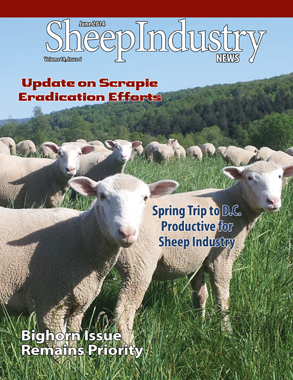
- June 2014
- President’s Notes
- Market Report
- Scrapie Eradication Remains Goal, but APHIS Hesitant About Timeline
- ASI Hosts Productivity Improvement Committee
- ASI’s 150th Blankets and Pillows Available Soon
- News Briefs
- Spring Trip to Nation’s Capital Called ‘Quite Productive’ for Sheep Industry
- Krebs Reminds Agency of NEPA Regulations in Bighorn Issue
- Superior Breaks Ground on New Facility
- Bighorn “Viability” Regulations Threaten Domestic Industry
- Running Rancher: Ken Wixom Brings Endurance to ASI’s Executive Board
- Study: Grouse Doing Well on Grazed Lands
- ‘Connect to Consumers’ Stressed During IWTO Congress
- Center of Nation Sale Features NSIP Sheep
- Obituaries
Scrapie Eradication Remains Goal, but APHIS Hesitant About Timeline
June 2014
WASHINGTON — Sheep producers on the spring trip to the nation’s capital were treated to small doses of promising news about USDA’s ongoing plans to eradicate scrapie across the country.
In a meeting with Dr. Jack Shere at USDA headquarters, producers, industry leaders and ASI staff learned that eliminating the disease by the year 2017 is still an attainable goal.
But the stretch run will be tough.
“Detecting the last cases of scrapie is always the most difficult – and the most costly,” Shere, associate deputy administrator of Animal and Plant Health Inspection Service’s (APHIS) Veterinary Services, told producers.
Shortly after the meeting, the office of Dr. John Clifford, chief veterinary officer at APHIS, clarified the producers’ direct question about the target date via e-mail by saying “it is likely that we will see a few cases occurring after 2017 and will not meet World Organization for Animal Health [OIE] criteria for freedom [no cases for 7 years] until at least 2024 and probably closer to 2036.”
The agency is also considering the proposition of a “negligible scrapie-risk” category, which was expected to be established by OIE any day.
“The negligible risk category opened up many markets for the beef industry and our current thinking is that having such a category for scrapie could be positive for the sheep industry, but we’ll need to review the details,” Shere noted. “It will be important, however, for the U.S. sheep industry to maintain at least its current level of surveillance and continue to work toward eradication.” Shere stressed that surveillance of goats will need to be ramped up to accomplish the goal.
In Fiscal Year 2013, APHIS tested 7,563 goats. The agency noted that since slaughter surveillance began, it has tested roughly 19,000 goats without finding any positive animals. However, a few positive goats have been found in clinical cases and in the testing of goats in infected sheep flocks. In summary, the prevalence of scrapie in goats, while not zero, is likely lower than 0.02 percent.
As for sheep, APHIS reported that in Fiscal year 2013 it tested 35,282 sheep, and that the prevalence of scrapie was determined to be less than 0.03 percent, a decline of 90 percent. At the start of slaughter surveillance in 2003, the prevalence was 0.2 percent.
Producers questioned whether or not a new OIE negligible risk category would ultimately slow the progress of eradication. Specifics on the proposed new category have not been released and APHIS could not answer that question.
“Changes to the OIE standards usually take one to two years once the revised standards have been drafted,” Clifford’s office replied after the meeting. “It is our understanding that the OIE has yet to begin drafting the revised Code Chapter on Scrapie.”

